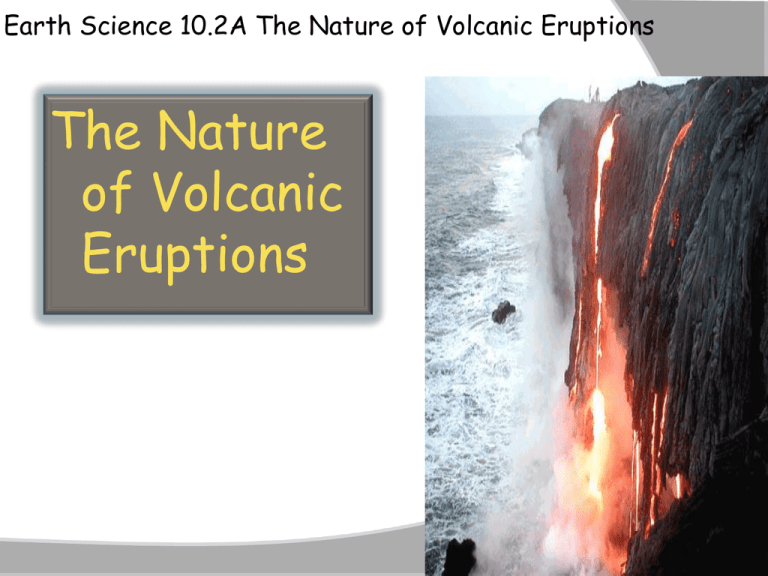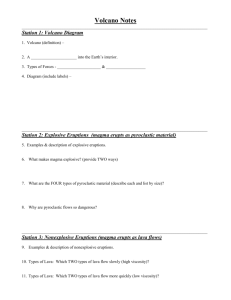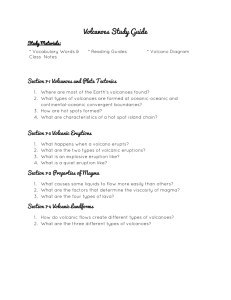Ch.10 – Section 2
advertisement

Earth Science 10.2A The Nature of Volcanic Eruptions The Nature of Volcanic Eruptions Earth Science 10.2 The Nature of Volcanic Eruptions On May 18th, 1980, Mount St. Helens erupted with tremendous force. The blast blew out the entire north side of the volcano. The eruption ejected nearly a cubic kilometer of ash and other debris. Earth Science 10.2 The Nature of Volcanic Eruptions The primary factors that determine whether a volcano erupts explosively or quietly include characteristics of the magma and the amount of dissolved gases in the magma. Magma that has reached the surface is called lava. Lava cools and hardens to form solid rock. Earth Science 10.2 The Nature of Volcanic Eruptions Magma’s viscosity , the thickness of the fluid, affects the type of eruption that occurs. Viscosity is a substance’s resistance to flow. For example; maple syrup is more viscous than water; it flows more slowly when you pour it. or The thicker the fluid, the slower and more viscous. The grade (5-30w) of a motor oil measures the viscosity of the oil, it’s thickness. Earth Science 10.2 The Nature of Volcanic Eruptions Magma from an explosive eruption may be thousands of times more viscous than magma that erupts quietly. The temperature and chemical composition determine the magma’s viscosity. The affect of temperature on viscosity is easy to see. If you heat maple syrup or honey it becomes more fluid and less viscous. In the same way, the viscosity of lava is strongly affected by temperature. As a lava flow cools, it becomes more viscous; thickening until it finally stops moving and hardens into rock. Earth Science 10.2 The Nature of Volcanic Eruptions The chemical composition of magma has a more important effect on the type of eruption. In general, the more silica in magma, the greater it’s viscosity (the thicker it stays when heated) Because of their high silica content; rhyolitic lavas are very viscous and erupt explosively. Earth Science 10.2 The Nature of Volcanic Eruptions Dissolved gases: During explosive eruptions, the gasses trapped in magma provide the force to propel molten rock out of the vent, an opening to the surface. These gases are mostly water vapor and carbon-dioxide. As magma moves nearer the surface, the pressure in the upper part of the magma is greatly reduced. The reduced pressure allows dissolved gases to be released suddenly. Earth Science 10.2 The Nature of Volcanic Eruptions Dissolved gases: Very fluid basaltic magma allows the expanding gases to bubble upward and escape relatively easily. Therefore, eruptions of fluid basaltic magma , such as those that occur in Hawaii, are relatively quiet. Earth Science 10.2 The Nature of Volcanic Eruptions Dissolved gases: But, highly viscous magma slows and traps the upward movement of expanding gases. The gases are trapped, collect in pockets that increase in size and build pressure. These pockets then explode when the pressure gets to a critical level and magma is ejected from the volcano in an explosive display. Earth Science 10.2 The Nature of Volcanic Eruptions Volcanic Material: Lava may appear to be the main material produced by a volcano but this is not always the case. Just as often, explosive eruptions eject huge clouds of broken rock, lava bombs, fine ash, and dust. Depending on the type of eruption, volcanoes may produce lava flows or eject “pyroclastic” materials or both. All volcanic eruptions also emit large amounts of gas. Earth Science 10.2 The Nature of Volcanic Eruptions Volcanic Material: Lava Flows: Silica content and temperature affect the characteristics of lava flows. Hot basaltic lavas are usually very fluid because of their low silica content. Flow rates of 10-300 meters per hour are common. In contrast, the movement of silicarich rhyolite lava is too slow to be visible. Earth Science 10.2 The Nature of Volcanic Eruptions Lava Flows: Temperature differences produce two types of basaltic lava: Pahoehoe lava Pahoehoe Aa Pahoehoe is a hotter, faster-moving, basaltic lava. Aa is cooler, slower-moving basaltic lava. Pahoehoe resembles braids in a twisted rope where Aa forms a surface of rough, jagged blocks of sharp, spiny projections. Aa lava Earth Science 10.2 The Nature of Volcanic Eruptions Gases: Magmas contain varied amounts of dissolved gasses held under pressure in the molten rock, just as carbon dioxide is held in a soft drink. Just like a soft drink, as soon as the pressure is reduced, the gases begin to escape. The gaseous portion of most magmas is only about 1 to 6 percent of the total weight. The percentage of gas may be small, but the actual quantity of emitted gas can exceed thousands of tons each day. Earth Science 10.2 The Nature of Volcanic Eruptions Gases: Samples taken during one Hawaiian eruption consisted of about 70 % water vapor 15% carbon dioxide 5 % nitrogen 5% sulfur And smaller amounts of chlorine, hydrogen, argon Earth Science 10.2 The Nature of Volcanic Eruptions Pyroclastic Materials: Particles produced in volcanic eruptions are called pyroclastic materials. When basaltic lava is extruded, dissolved gases propel chunks of lava to great heights. Some of this ejected material may land near the vent and build a coneshaped structure. The wind will carry particles great distances. Viscous rhyolitic magmas are highly charged with gases. As the gases expand, pulverized rock and lava fragments are blown from the vent. Earth Science 10.2 The Nature of Volcanic Eruptions Pyroclastic Materials: The fragments ejected during eruptions range in size from very fine dust and volcanic ash to pieces that weigh several tons. Particles that range in size from small beads to walnuts (2-64 millimeters) are called lapilli, or cinders. Particles larger than lapilli are called blocks when they are made of hardened lava and bombs when they are ejected as glowing lava. Computer Lab: Use the internet to research the following topic and write a short 3 paragraphs summarizing the topic. DONOT COPY CUT OR PASTE: “The plaster casts at right were taken from the archeological dig at Pompeii. How were these made by a volcanic eruption?” Earth Science 10.2B Volcanic Eruptions The Nature of Volcanic Eruptions Part B Types of Volcanoes: Volcanic landforms come in a wide variety of shapes and sizes. The three main types of volcanoes are Shield volcanoes Cinder cones Composite cones (stratovolcano) Types of Volcanoes: Anatomy of a Volcano Volcanic activity begins when a fissure, or crack, develops in the crust as magma is forced toward the surface. The gas rich magma rises from the magma chamber, travels through a circular pipe, and reaches the surface at a vent. Repeated eruptions of lava or pyroclastic material eventually build a mountain called a volcano. Located at the summit of many steep walled volcanoes is a depression called a crater. Types of Volcanoes: Anatomy of a Volcano: The form of the volcano is largely determined by the composition of the magma. Fluid lavas tend to build broad structures with gentle slopes while more viscous, silica-rich lavas produce cones with steeper slopes. Types of Volcanoes: Shield Volcanoes: Shield volcanoes are produced by the accumulation of fluid basaltic lavas. Shield volcanoes have the shape of a broad , slightly domed structure that resembles a warrior’s shield. Most shield volcanoes have grown up from the deepocean floor to form islands. Examples of shield volcanoes include the Hawaiian Islands and Iceland. Types of Volcanoes: Cinder Cones: Ejected lava fragments that harden in the air build a cinder cone. The fragments range in size from fine ash to bombs but consist of lapilli, or cinders. Cinder cones are usually a product of relatively gas-rich basaltic or rhyolitic magma. Occasionally cinder cones produce lava flows. Types of Volcanoes: Cinder Cones: Cinder cones are usually a product of a single eruption that sometimes lasts only a few weeks and rarely more than a few years. Once the eruption ends, the magma in the pipe connecting the vent to the magma chamber solidifies, and the volcano never erupts again. Compared to shield volcanoes, cinder cones are relatively small. Types of Volcanoes: Composite Cones: Earth’s most beautiful and potentially most dangerous volcanoes are composite cones or stratovolcanoes. A composite cone is a large, nearly symmetrical volcanic mountain composed of layers of both lava and pyroclastic deposits. Composite cones are the product of gas-rich magma having an andesitic composition. Types of Volcanoes: Composite Cones: The silica-rich magmas typical of composite cones generate thick viscous lava that can travel only short distances. Composite cones may generate the most explosive eruptions, ejecting huge amounts of pyroclastic materials. Most composite cones are located in a relatively narrow zone that rims the Pacific ocean that we call the “Ring of Fire”. Types of Volcanoes: Composite Cones: The Ring of Fire includes the large cones of the Andes in South America and the cascade range of the western United States and Canada. The Cascade Range includes Mount St. Helens, Mount Rainer, and Mount Shasta. The most active regions in the Ring of Fire are located along volcanic island arcs next to deep ocean trenches. Mount Rainier Types of Volcanoes: Other Volcanic Landforms: Volcanic mountains are not the only landform to result from volcanic activity calderas volcanic necks lava plateaus also are byproducts. Caldera Lava plateau Volcanic neck Types of Volcanoes: Calderas: A caldera is a depression in a volcanic mountain. Most calderas form in one of two ways By the collapse of the top of a composite volcano after an explosive eruption From the collapse of the top of a shield volcano after the magma chamber is drained Caldera Types of Volcanoes: Calderas: Crater Lake in Oregon occupies a caldera. This caldera formed about 7000 years ago when a composite cone, Mount Mazama, erupted violently. The eruption of Mount Mazama partly emptied the magma chamber. The roof of the magma chamber then collapsed, forming a huge depression which today contains Crater Lake. A later eruption produced Wizard Island, the small cinder cone now an island in the lake’s middle. Crater Lake Oregon Types of Volcanoes: Volcanic Necks: Another volcanic landform that provides evidence of past volcanic activity is the volcanic neck. A volcanic neck is a landform made of magma that hardened in a volcano’s pipe and later was exposed when the volcano eroded away. When a volcano’s activity ends, the magma remaining in the pipe hardens to form igneous rock. Devil’s Tower Types of Volcanoes: Volcanic Necks: Weathering and erosion act constantly to wear away at volcanoes. Cinder cones are easily eroded because they are made of loose materials. But the rock in the volcano’s pipe is more resistant to erosion, so it is left standing above the surrounding land after most of the cone has been eroded away. Devil’s Tower Types of Volcanoes: Lava Plateaus: If you visited the Colombia River Gorge in Washington, you would see huge cliffs made up of layers of dark, volcanic rock. These layers of rock are part of the Colombia Plateau, a huge lava plateau that covers much of Washington, Oregon and Idaho. A lava plateau is a volcanic landform produced by repeated eruptions of very fluid, basaltic lava. Types of Volcanoes: Lava Plateaus: The lava that forms a lava plateau erupts through long cracks called fissures. Instead of building a cone, the lava spreads out over a large area. The Colombia Plateau is almost 1.6 kilometers thick. The plateau formed over hundreds of thousands of years as a series of lava flows, some 50 meters thick, buried the landscape. Types of Volcanoes: Volcanic Hazards: Throughout history, people often have settled near volcanoes because of the rich volcanic soils surrounding it. However, a dormant volcano may become active with no warning. Volcano hazards include lava flows, volcanic ash, pyroclastic flows, and mudflows. Types of Volcanoes: Volcanic Hazards: Lava flows are a major volcanic hazard. Frequent lava flows from Mount Kilauea in Hawaii destroys anything in it’s path. Active composite volcanoes, like those in the Cascade Range, are among the most dangerous volcanoes. A composite volcano can eject huge quantities of volcanic ash, burying widespread areas under thick ash deposits. Types of Volcanoes: Volcanic Hazards: An explosive eruption can also release a pyroclastic flow; a scorching mixture of glowing volcanic particles and gases that sweeps rapidly down the sides of a volcano. In 1902, a pyroclastic flow from Mount Pelee on the island of Martinique killed 29,000 people. Composite volcanoes may also produce mudflows called lahars. A lahar occurs when water-soaked volcanic ash and rock slide rapidly downhill. Ice and snow melted by an eruption can trigger a lahar. Computer Lab: Use the internet to research one of the following topics and write one paragraph on the subject. DO NOT COPY CUT OR PASTE: Choose one of the following and write a paragraph on how it was formed or influenced by volcanic activity Devils Tower Crater Lake Colombia River Gorge Pompeii Italy, the destruction of. . .







